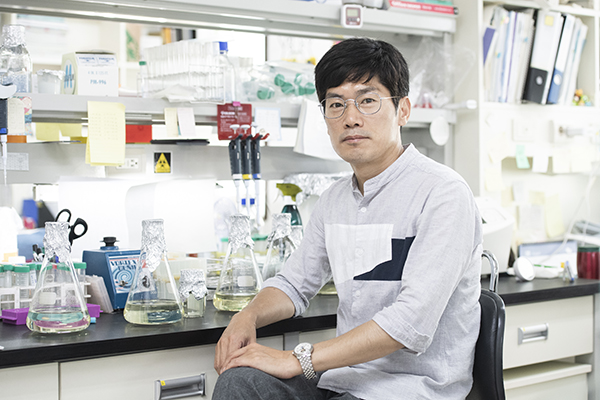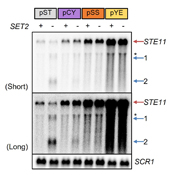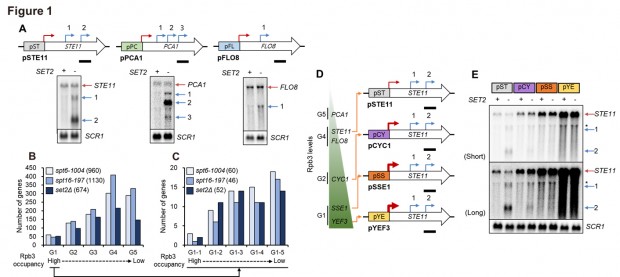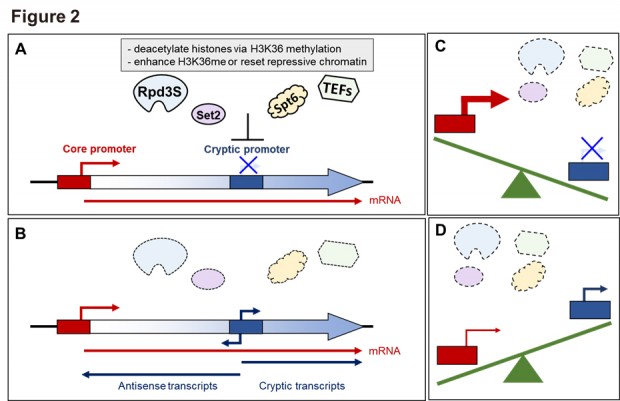본문
Core promoter activity contributes to chromatin-based regulation of internal cryptic promoter

By Prof. Tae Soo Kim
Department of Life Science
PURE Research Profile
tskim@ewha.ac.kr
During RNA polymerase II (RNA Pol II) transcription, the chromatin structure undergoes dynamic changes, including opening and closing of the nucleosome to enhance transcription elongation and fidelity. These changes are mediated by transcription elongation factors, including Spt6, the FACT complex, and the Set2-Rpd3S HDAC pathway. Mutants for these factors have shown to activate large numbers of internal cryptic promoters. In addition, recent studies have suggested that the Set2-Rpd3S HDAC pathway mainly affects the internal cryptic promoters of infrequently transcribed long genes. However, the commonalities of the genes that produce these cryptic transcripts have not been poorly defined. It also remains unclear whether RNA Pol II transcription frequency negatively correlates with transcription initiation from internal cryptic promoters and why highly active genes do not produce cryptic transcript.
To address this question, the weak core promoters of genes (e.g. STE11) that generate cryptic transcripts in cells lacking transcription elongation factors were replaced with a hyperactive one. Interestingly, we showed that high core promoter activity directly repressed internal cryptic promoters, even in mutants for the transcription elongation factors that displayed ample cryptic transcription. Highly active core promoters also blocked the histone modifications that were observed at active internal cryptic promoters. When the weak core promoter of genes with active internal cryptic promoters was replaced with a hyperactive one, histone H3 and H4 acetylation and trimethyl H3K4 (H3K4me3) were not seen.
Moreover, when the core promoter activity was downregulated by environmental changes or by mutating transcription elongation factors, initiation from the internal cryptic promoters increased. These findings suggest that core promoter strength plays a critical role in the regulation of internal cryptic promoters and that the two promoters may communicate with each other to control their activities.
In summary, we show, for the first time, that hyperactive transcription from the core promoter may prevent the transcription machinery from binding to the internal cryptic promoter, thereby inhibiting cryptic transcription. An important question is, why does the internal cryptic promoter become inactivated if the core promoter is hyperactive? A simple explanation is transcriptional interference that the enhanced transcription from the core promoter by RNA Pol II blocks the formation of the preinitiation complex at the internal cryptic promoter. We therefore propose that the chromatin-based regulation of internal cryptic promoters is mediated by core promoter strength as well as transcription elongation factors.
Figure 1. RNA Pol II transcription frequency correlates negatively with cryptic initiation.
(A) Set2 suppresses the internal cryptic transcription of STE11, PCA1, and FLO8. (B and C) The genes that produce cryptic transcripts in the set2∆, spt6-1004, and spt16-197 mutants tend to have lower Rpb3 occupancy. (D and E) Strong core promoter activity reduces cryptic initiation in SET2-deleted cells. (D) Schematic representation of the STE11 gene in which the original promoter (wild-type gene, pST-STE11, grey) was replaced by the promoter from two strongly transcribed genes (G1 group; YEF3 and SSE1) or a more weakly transcribed gene (G2 group; CYC1). These variants are respectively designated pYE-STE11 (yellow), pSS-STE11 (orange), and pCY-STE11 (violet). (E) Wild-type and set2∆ cells with the indicated STE11 variants were grown as described in (A) and then subjected to northern blot analysis of the STE11 and cryptic transcripts.
Figure 2. Models for regulation of internal cryptic promoters by core promoter activity.
* Related Article
Bo Bae Lee, Hyeonju Woo, Min Kyung Lee, SeoJung Youn, Sumin Lee, Jae-Seok Roe, Soo Young Lee, TaeSoo Kim, Core promoter activity contributes to chromatin-based regulation of internal cryptic promoters, Nucleic Acids Research, Volume 49, Issue 14, 20 August 2021, Pages 8097–8109


